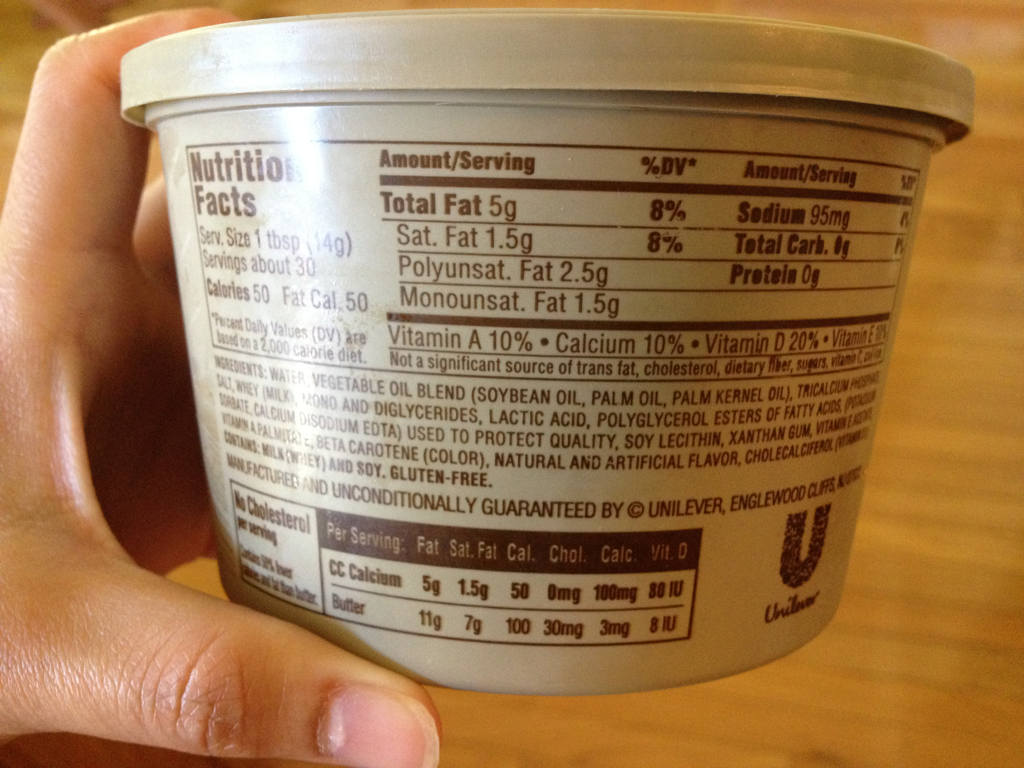Iukina
Can someone please explain to me why country crocks margarine spread has no listing of partially hydrogenated oil and yet, is solid at room temperature.
Margarine is solid and made through the process of hydrogenation which is adding hydrogen to vegetable oil such as cottonseed and soybean oils. This mechanism leads to trans fat. The FDA allows manufacturers to label their products 0 g of trans fat if it has .5 or lower grams. Also, the statement “not a significance source of _____ ” basically means it has .5 or lower grams. So technically, this margarine does have trans fat. This could be very misleading to someone thinking it has no trans fat.
I came across this article on transfat:
No more hydrogenated oils used in tub margarine? Zip, zero, nada? Unilever is showing consumers that it can be done. From the middle of August and into the fall, you’ll start seeing “non-hydrogenated” on the front of two brands of tub margarine – I Can’t Believe It’s Not Butter and Brummel & Brown, with the rest of Unilever’s tub margarine brands (Country Crock and Imperial) following in the beginning of 2010.
Unilever is completely removing partially hydrogenated vegetable oil from their tub margarines, which means they are completely eliminating artificial trans fats from these products. And don’t think they are trading one dangerous fat for another either. Each of the spreads will still contain 2 grams of saturated fat or less per tablespoon.
Stick margarines in these brands will still contain some partially hydrogenated oil but Unilever’s long-term goal is to remove partially hydrogenated oil from stick margarine as well. If the brands aren’t replacing partially hydrogenated oils with saturated fat, how then are they creating thick textured tub margarine? The overall technology to manufacture these new “non-hydrogenated” tub margarines is proprietary, according to Doug Balentine, PhD, Unilever Director of Nutrition Science in the Americas, but the process does seem to involve the re-arrangement of fatty acids creating interesterified fats (more on this in a future blog).
You can expect the same great taste in the margarines and the nutrition information label might even look the same as before but this time when you see “0″ grams next to trans fat, it really will be zero!
- Elaine Magee, MPH, RD
So, could it be that interesterification (removing fatty acids from glycerol or recombinating numerous configuration - Peter S. Murano, Understanding Food Science and Technology) is responsible for the semi-solid product? There have been studies that state that this method isn’t any better.
Beyond this point, I have no further information. Is Country Crock using interesterification? What is it on the label that points to that direction? How is the labeling working? One thing I’m sure of is that this product does contain .5 or less grams of trans fat. Be careful when reading the labels. Remember, manufacturers are still allowed to say NO trans fat or 0g trans fat if it has .5g or less. Read the “not a significant source” because that just means there is.
ioseppa reblogged this from betterthancookingmama
betterthancookingmama posted this
